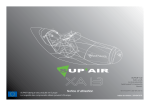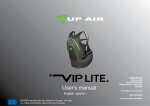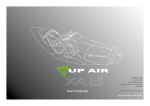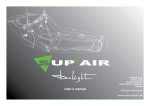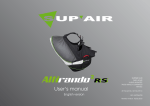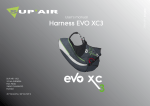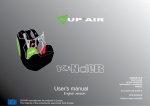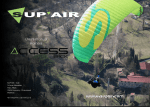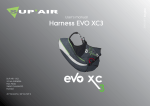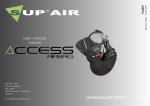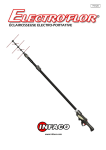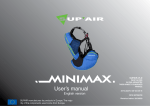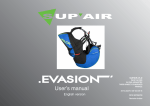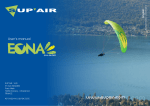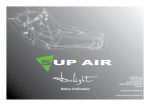Download User`s manual
Transcript
SUPAIR-VLD PARC ALTAÏS 34 RUE ADRASTÉE 74650 ANNECY CHAVANOD FRANCE User’s manual SUPAIR manufactures its products in Europe. The majo rity of the components used come from Europe. 45°54.024’N / 06°04.725’ E Indice de révision : 20140416 EN Thank you for your choice of a Supair XA13. We are proud to join you on your journey in our common passion : paragliding. SUP’AIR has been designing, producing and selling accessories for free flying activities since 1984. By choosing a SUP’AIR product you benefit from almost thirty years of expertise, innovation and listening. This is also our philosophy : working endlessly to develop better products and to maintain a high quality production in Europe. We trust that you will find this user’s manual comprehensive, explicit and hopefully pleasant to read. We advise you to read it carefully ! On our website www.supair.com, you will find the last up to date information about this product. If you have any further questions, feel free to ask one of our retailers. And of course, the entire SUP’AIR team are at your disposal through [email protected] We wish you many safe flying and enjoyable hours, and happy landings The SUP’AIR team Design, development, project managing : Bruno DELOUSTAL Technical advisor, test pilot : Clément LATOUR Additionnal test pilot : Victor SEBE Prototyping : Virginie BAUD, Khadija AMER Production : Romania 2 Table contents Table contents Introduction Technical sheet Technical specifications Size choice Nomenclature Harness overview BUMPAIR 12 XA13 Connecting the handle to the rescue parachute’s Rescue parachute assembly Connecting the rescue parachute risers to the harness Placing the parachute in the rescue parachute pocket Speedbag angle setting Leaning angle setting Shoulders’ straps adjustment Comportement en vol Pre-Flight control Take-off In flight Speedbar use 3 4 5 5 6 7 8 9 10 10 11 12 13 13 13 14 15 16 16 16 Landing Throwing the reserve parachute Wash and care of your harness Lifetime Care Repair Materials Recycling Environmental friendly practices Warranty Disclaimer Pilot’s gear Warranty Service Book 17 17 18 18 18 19 19 19 19 20 20 20 20 21 Crédits photos : Horacio LLorens; Bruno DELOUSTAL; SUPAIR 3 Introduction Welcome to the world of lightweight performance! You have in your hands the key that opens the door to exceptional flights. The XA13 is our most persuasive invitation to adventure and with it you will be able to go higher, further and fly longer. Now, you just have to find a playground big enough ! After reading this manual, we suggest you check your harness by hanging in it before flying. N.B : Three important icons will help you when reading this manual Advice Caution ! Danger !! 4 Technical specifications Model XA13 S XA13 M XA13 L XA13 XL Pilot size Weight Harness weight (+ carabiners+speedbar) 155-170 60-75 2330g 165-180 175-190 185-200 70-80 75-85 75-100 2370g 2390g 2482g Technical sheet A Back height (cm) Leaning setting height B (cm) A Hauteur du dos D C D l'inclinaison du dossier Seat width Longueur d'assise Carabiners (cm) F Carabiners (cm) E Hauteur des points F Distance entre les (cm) points Seat réglage length (cm) C Hauteur de B E (cm) G G height Designed for Back height (cm) distance Leaning setting height (cm) Seat length (cm) Seat width (cm) length Carabiners height (cm) Carabiners distance (cm) Speedbag length (cm) Impact damping system : Airbag (Volume): Speedbag Longueur speedbag Largeur d'assise Impact damping system : Bumpair (Thickness) Homologation Flight : tandem (Pilot- Passenger) Flight : acrobatic flying Winching F Paragliding only 60 38 36 42 40 34 - 44 110-120 66 71 75 42 44 48 40 44 48 44 46 49 42 44 46 34 -44 34 - 44 34 - 44 115-125 119-129 123-133 Yes Yes- 12 cm EN 1651 - LTF No-No No Yes E A B D C G 5 Size choice Choosing your harness’ size is important. You will find here below a height/weight table that will help you in your size choice. With its hammock architecture and its “lying flat” flying position, we advise you to try out the harness under a hanging device at one of our retailers in order to choose the correct size. For a complete list of our retailers, please click here : www.supair.com Size Weight 60 65 70 75 80 85 90 95 100 105 1m55 1m60 1m65 1m70 1m75 1m80 1m85 1m90 1m95 S S S S S S S S S M S S S M M 2m 2m05 S M M M L M M L L L L XL XL XL L XL XL XL XL XL XL XL XL XL XL XL XL XL XL XL XL XL L XL Preliminary test under hanging device 6 Nomenclature 1 Speedbar light 2 Rescue parachute handle, F-Side 3 Footrest S-M-L MPPL010 XL MPPL024 4 BUMPAIR 12 XA13 5 6 7 1 2 3 4 Connects 5 9 Solo Dyneema individual risers 7mm Maillon Rapide® 8 Toric ring ( x2 ) 9 Adhesive Ripstop 6 7 8 7 Harness overview 5 6 3 5 4 2 3 4 6 1 Thigh strap buckle 2 Ventral width adjustment 3 Leaning setting 4 Lumbar support setting 1 1 10 5 6 7 6 6 7 8 8 Shoulders’straps adjustment speedbag leaning adjustment Footrest Speedbag closing buckles 9 9 Rescue parachute handle 10 Harken® Pulleys 8 8 BUMPAIR 12 XA13 9 Rescue parachute assembly Connecting the handle to the rescue parachute’s deployment bag Thanks for reading carefully ! We recommend the initial rescue parachute assembly and installation is made by a qualified person. A B C A: D B: Standard Risers : use one Maillon Rapide ® Inox 7 mm. see page 13 1. Place the handle inside the middle webbing loop and make a lark’s head knot with the handle. A XA13 rescue parachute handle B Parachute folded according to manufacturers specification and in deployment bag. C Parachute rigging lines D Parachute risers 2. Fasten tightly the lark’s head knot and verify the solidity of the link. 10 Connecting the rescue parachute risers to the harness : standard risers Your XA13 is fitted with light standard parachute risers 1. Make a lark’s head between the risers and the webbing loop for rescue attachment. 2. lark’s Fasten head the neatly 1 2 1 Rescue standard parachute risers 2 Webbing loop for rescue risers attachment 3. Neatly plus risers stow under any surthe flaps. 11 Placing the parachute in the rescue parachute pocket A A A Upper flap grommets B Under flap grommets B Thanks for reading carefully ! We recommend the initial rescue parachute installation is made by a qualified person. B 1. Place the risers’ straps and the 2. Place the parachute rigging lines of the parachute in its pod on top of the risers and lines. clearly coiled When the assembly is complete, perform a test pull of the handle to ensure the compatibility and the correct deployment of the rescue (pod + handle). Then reassemble as previously done. 5. Pass the snapper through the C grommet and pass the handle’s cable inside the hole of the down flap and finally inside the snapper. Pull away gently the line 6. Place the line through the other snapper in the A and D grommets (up and down flaps). Repeat step #5. 3. Take a suitable line and pass it inside the snapper on handle’s side. 7. Put the cable trim inside the flap pocket 4. Pull the snapper and pass it through the B grommet. 8. Turn down the last flap and place the handle on its velcro. 12 A Speedbag angle setting With the help of the two lateral and under seating buckles, set the angle of the Speedbag around horizontal position. 5 6 B Leaning angle setting Change the inclination by tightening the 3 webbing (to be more vertical) or by loosening it (to be more horizontal) 3 5 6 3 4 1 4 1 You can increase or decrease the lumbar support by loosening the 4 buckle 2 Caution : these settings are only possible under portal C 2 Shoulders’ straps adjustment Tighten the shoulders’ straps with the 5 webbing Loosen with the 6 webbing The support of the shoulders’ straps greatly helps comfort. It should be set precisely. The settings webbings and the chest strap must be IMPERATIVELY put back inside the frames. It is STRICTLY forbidden to cut or unstitch the webbings’ends as they are integral part of the harness rigidity and EN1651 certification adn consequently to your safety ! 13 Comportement en vol The XA13 has been designed for 2013 Redbull X-Alps. It is consequently a very performent harness. We have lightened whenever possible but wihout any compromise on both active and passive security Fligh behaviour is very stable and will enable you to fly in the very strong conditions one may encounter on suche journey. 14 Pre-Flight control After a thorough weather conditions analysis, when the decision to fly has been taken, fit into the harness : • Check that the harness and the carabiners did not deteriorate. • Check thoroughly that the rescue handle’s cable end has not got outside the snappers’ flaps. • Check that your personal settings haven’t changed. • Check that all zippers and buckles are closed. • Check that the speedbar is correctly connected and set. • Check that no rigging line or other object comes in contact with rescue parachute handle. • Fasten the buckles (thigh straps, safe-T-bar and ventral buckles) with application. Check that the carabiners are correctly locked. 2 1 3 4 3 1 2 3 4 Thigh strap buckle Thigh strap buckle Boucle de fermeture du speedbag (volet droit) Boucle de fermeture du speedbag (volet gauche) 15 Take-off After being correctly fitted into your harness, fasten the left buckle (1, on braided rope) of the speedbag then fasten the second speedbag buckle (2). During take-off, maintain a standing position and as soon as you are far enough from the ground, fetch the speedbag with one of your heels. With help of the foot-rest, push back into your harness. In flight Do not release your hands from the brakes when you are close to the ridge. As soon as you are airborne, the behaviour is very instinctive and precise. Please set the distance between the two carabiners according to aerology and to wing’s manufacturer recommendations Tightening provides more stability but less harness piloting efficiency. Be careful as it increases the risk of risers twisting. On the contrary, loosening the strap provides more efficiency but can be dangerous by turbulent aerology (increased risk of falling towards the collapsed side of your glider). Speedbar use We recommend a careful use of the speedbar because of an increased risk of massive collapse. Please read carefully the manual of your glider. To use the speedbar, maintain one foot on the footrest then with the other, place your foot onto the centering space and push the first bar. This spacer helps you to obtain a symmetrical acceleration. Cette cale vous permet une accélération symétrique. Once your foot touches the footrest, use the other foot to push the second bar. 16 Landing In order to land, during the approach, take your legs out of the speedbag in plenty of time. Stand up inside the harness and adopt an upright position in order to run to dissipate horizontal speed. Do not land whilst in the seated position, this is dangerous. Throwing the reserve parachute We strongly advise you to check frequently the location of the reserve parachute’s handle. To do this, we recommend that you lower your right hand following the risers. This movement should be done without looking. By doing this, you increase your chances in case something goes wrong and you need to throw the reserve parachute. Evaluate your height from the ground. If you have a lot of altitude, it may be better to attempt to recover your wing to normal flight, But if you are in any doubt, deploy your rescue parachute. Deploying a rescue parachute should be done only in an emergency. With a strong, lateral and then vertical tug, pull the handle towards you and then throw the whole parachute (including the bag and handle) as hard as you can towards a clear area of sky. As soon as the parachute deploys, haul down the glider by pulling as symmetrically as you can the risers (C or d D) or on the brakes. Be prepared to land by adopting an upright position, with knees together and legs slightly bent. Prepare to roll down with pivoting shoulders. 17 Care Wash and care of your harness It is a good idea to wash your harness from time to time. To do this, we recommend to use a soft solvent (such as soap), use a brush and rinse thoroughly. In any case, do not use chemicals such as detergents or strong solvent because it may deteriorate the webbing, stitching and fabrics of your harness. Lifetime The threads that compose the webbing and fabrics used in the XA13 have been selected in order to ensure the best possible lightness/lifetime compromise. Nonetheless, in some conditions, after a long term exposure to UV and/or significant abrasion or exposure to chemicals, it is compulsory to check your harness in a certified repair centre. It is about your safety. 18 Repair Though we use the highest quality materials, it is possible that your harness may eventually deteriorate through general use. If its is showing any signs of significant wear and tear, you should check it and repair it in an certified repair centre. SUP’AIR offer a repair facility for their products beyond the end of the warranty period. Please contact us either by telephone or by E-mail [email protected] in order to receive a quotation. Materials Recycling Fabrics RIPSTOP cordura armé vectran Skytex 38 gr Speedbag LYCRA MEMBRANE Webbings Polyamide 20 mm (500 DaN) Polyester 22 mm (1100 DaN) If you judge your XA13 has finished its life, you can separate all the plastic and metallic parts and apply up-to-date sorting rules in effect in your community. For recycling of the fabric parts, we advise you to contact your local authority that deals with fabric recycling. Environmental friendly practices We highly recommend you to respect as much as possible our environment while practicing paragliding and especially : not to go outside tracks, do not make unwanted noise and do not disturb the mountain areas’ balance. We advise you to do this starting from the take-off. 19 Warranty Warranty SUP’AIR takes the greatest care in the design and production of its products. SUP’AIR guarantees its products 5 years (from purchase date) against any defect or design fault occurring during normal use. Any damage or degradation resulting from incorrect or abusive use, abnormal exposure to aggressive factors, including, but not limited to; high temperature, intense sun exposure, high humidity etc will invalidate this warranty Disclaimer Paragliding is an activity that requires, skill, specific knowledge and sound judgement. Be careful, learn in certified schools, subscribe an adequate insurance policy as well as a flying license and make sure your skill match the conditions. SUP’AIR cannot be held responsible for your paragliding decisions or activities This SUP’AIR product has been designed exclusively for paragliding. Any other activity such as skydiving or BASE jumping is absolutely forbidden. Pilot’s gear This is essential that you carry a helmet, suitable boots and clothing. Taking a reserve parachute suitable for your weight and correctly connected to your harness is also very important. 20 Service Book This page will help you to record all the life stages of your XA13 harness. Purchase date Owner’s name Name and stamp of the shop Care Resale Date Workshop’s name/ Buyer’s name Care Resale Date Workshop’s name/ Buyer’s name Care Resale Date Workshop’s name/ Buyer’s name Care Resale Date Workshop’s name/ Buyer’s name 21 SUPAIR-VLD PARC ALTAÏS 34 RUE ADRASTÉE 74650 ANNECY CHAVANOD FRANCE 45°54.024’N / 06°04.725’ E






















